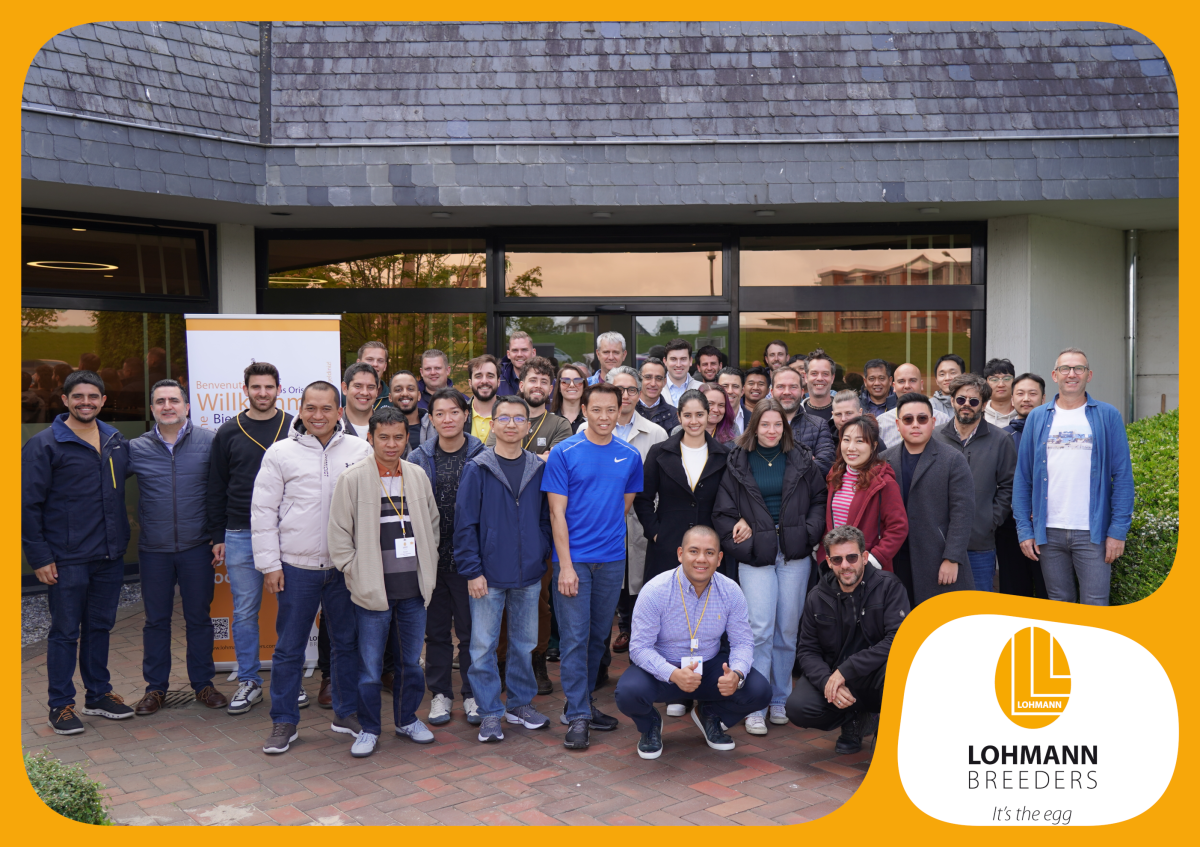The Beginning
Breeding of hybrid laying hens in Cuxhaven started in 1959, based on a license agreement with Heisdorf & Nelson Farms (H&N), a leading breeding company for hybrid laying hens in the USA. H&N had won many random sample tests with the “H&N Nick Chick”, a White Leghorn strain cross with superior combining ability, and Art Heisdorf was convinced that the application of reciprocal recurrent selection (RRS) would assure genetic progress for many years.
HNL Nick Chick
Based on this license agreemen, LOHMANN started to adapt the performance profile of the “HNL Nick Chick” to the European egg market. In 1969, when I started to work in Cuxhaven, the HNL Nick Chick had an excellent image, and the number of parents placed in Germany had increased to more than 500,000 in 1969/70. Compared to other White Leghorns, HNL layers known for their calm behavior and superior egg quality. During the following years, we changed the breeding program step-bystep and monitored genetic improvement, based on internal “repeat mating controls”, official random sample tests and field reports.

Improve genetic resistance to Marek’s disease?
One of the questions was whether we should try to improve genetic resistance to Marek’s disease (MD). Before MD vaccines became available, pedigreed test flocks were exposed to a challenge on a farm in Spain with a history of MD losses. In three generations of progeny-testing, we reduced MD mortality by 20% in a set of sub-lines, while egg production of the main lines increased significantly. Soon after MD vaccines were introduced in practice, the sub-lines were discontinued. The cumulative results are published in Muir and Aggrey (2003).
Testing methods
Egg production of pedigreed test crosses was recorded in floor pens with trap-nesting and single cages before my time. Since floor testing was more expensive and results less accurate than from single cages, we decided to expand single cage testing and added tests in group cages under field conditions. A statistical analysis of six years data with paternal half-sib groups in single cages vs. group cages showed a high genetic correlation for most traits, except mortality. Before each selection and reproduction of a new generation, genetic parameters were estimated from the current generation and emphasis on individual traits reviewed in view of changing priorities in different segments of the egg market.
From challenges to chances
During the 1970s, egg producers were challenged by rising feed prices and overproduction of eggs. Mortality of pullets had been reduced since the introduction of MD vaccination, and per capita egg consumption declined due to concerns about salmonella infections, cholesterol and animal welfare. As a result, LOHMANN TIERZUCHT sold fewer white-egg parents in Germany and focused on additional exports. At the same time, we started to record individual feed intake and selected for maximum egg income over feed cost.

Feather sexing
After the end of the license agreement with H&N (in the meantime acquired by Pfizer) and entry into the world market, we learned that it is easier to develop a competitive brown-egg layer than to change consumer demand to whiteshelled eggs, which can be produced at lower cost and have the same shell strength and better internal quality. Hatcheries placing LOHMANN Brown parents soon recognized the advantage of color-sexing and became interested in feather-sexing White Leghorns.
Improvement of parent performance
One of the questions we wanted to answer was, whether a modification of RRS to include pure-line performance could help to improve parent performance, without compromising the rate of progress for commercial hybrids. We estimated heterosis in 1973/74 after longterm RRS, based on pure-line and crossline daughters reproduced simultaneously by artificial insemination and tested in single cages; results were presented at the European Poultry Conference in Hamburg (1980). When we compared pure-line and cross-line results again in 1986/87 for the LSL lines, the reciprocal crosses had gained 2 eggs per year (318 vs. 292 eggs) and the pure-lines 3 eggs per year (288 vs. 249 eggs in 52 weeks).
Introduction of LOHMANN BROWN
When LOHMANN BROWN was first introduced, some hatcheries complained that they did not reach the hatchability specified in the management program and were short of chicks. I then resisted the suggestion to reduce the standards and instead promised genetic improvements in the near future. One my graduate students, Anke Förster (1993), started with this problem for her thesis, analyzed reasons for poor hatchability and helped to solve this problem.
When Art Heisdorf decided to start with RRS, a strong argument was that this breeding scheme did not require inbreeding to generate new crosses. However, intensive selection always leads to some inbreeding, which can be estimated from the “effective population size”. Hossein Ameli (1989) estimated the rate of inbreeding from a large volume of pedigree data from the original HNL lines, after 12 generation classical RRS (ignoring pure-line performance) and 12 years combined selection on cross-line and pure-line performance (mRRS).

Focus of genetic improvement
While the focus of genetic improvement was always on efficient egg production, we invested a lot in shell quality, especially shell strength in white-egg lines and shell color in brown-egg lines. Many people expect a negative correlation between the rate of egg production and shell strength.
Shell color of brown-egg strains has nothing to do with the nutritional value of eggs, but is often used as sales criterion and therefore has been given attention in the Lohmann Brown breeding program, based on photometric measurement (La- b Index) and subjective scoring. Unfortunately dark shell color is correlated with the incidence of blood and meat spots.
Dietmar K. Flock
Breeding of hybrid laying hens in Cuxhaven started in 1959, based on a license agreement with Heisdorf & Nelson Farms (H&N), a leading breeding company for hybrid laying hens in the USA. H&N had won many random sample tests with the “H&N Nick Chick”, a White Leghorn strain cross with superior combining ability, and Art Heisdorf was convinced that the application of reciprocal recurrent selection (RRS) would assure genetic progress for many years.
HNL Nick Chick
Based on this license agreemen, LOHMANN started to adapt the performance profile of the “HNL Nick Chick” to the European egg market. In 1969, when I started to work in Cuxhaven, the HNL Nick Chick had an excellent image, and the number of parents placed in Germany had increased to more than 500,000 in 1969/70. Compared to other White Leghorns, HNL layers known for their calm behavior and superior egg quality. During the following years, we changed the breeding program step-bystep and monitored genetic improvement, based on internal “repeat mating controls”, official random sample tests and field reports.
During my initial training at H&N (1968/69) I learned about the history of breeding egg-type chickens since the rediscovery of Mendel’s laws, almost 100 years ago, and expected to learn more about potential improvements from analyzing pedigreed records of the HNL lines, performance under field conditions and discussion with partners in the egg industry.

Improve genetic resistance to Marek’s disease?
One of the questions was whether we should try to improve genetic resistance to Marek’s disease (MD). Before MD vaccines became available, pedigreed test flocks were exposed to a challenge on a farm in Spain with a history of MD losses. In three generations of progeny-testing, we reduced MD mortality by 20% in a set of sub-lines, while egg production of the main lines increased significantly. Soon after MD vaccines were introduced in practice, the sub-lines were discontinued. The cumulative results are published in Muir and Aggrey (2003).
Testing methods
Egg production of pedigreed test crosses was recorded in floor pens with trap-nesting and single cages before my time. Since floor testing was more expensive and results less accurate than from single cages, we decided to expand single cage testing and added tests in group cages under field conditions. A statistical analysis of six years data with paternal half-sib groups in single cages vs. group cages showed a high genetic correlation for most traits, except mortality. Before each selection and reproduction of a new generation, genetic parameters were estimated from the current generation and emphasis on individual traits reviewed in view of changing priorities in different segments of the egg market.
From challenges to chances
During the 1970s, egg producers were challenged by rising feed prices and overproduction of eggs. Mortality of pullets had been reduced since the introduction of MD vaccination, and per capita egg consumption declined due to concerns about salmonella infections, cholesterol and animal welfare. As a result, LOHMANN TIERZUCHT sold fewer white-egg parents in Germany and focused on additional exports. At the same time, we started to record individual feed intake and selected for maximum egg income over feed cost.

Feather sexing
After the end of the license agreement with H&N (in the meantime acquired by Pfizer) and entry into the world market, we learned that it is easier to develop a competitive brown-egg layer than to change consumer demand to whiteshelled eggs, which can be produced at lower cost and have the same shell strength and better internal quality. Hatcheries placing LOHMANN Brown parents soon recognized the advantage of color-sexing and became interested in feather-sexing White Leghorns.
We knew from the literature and the experience of other companies that feathersexing White Leghorns are susceptible to Lymphoid Leucosis (LL). While introducing the gene for slow feathering (K) from an experimental line into the LSL female line (10 generations backcrossing), the pedigree generation of all lines was screened for LL carriers, and field testing with LSL-F started after the virus had been eradicated.
Improvement of parent performance
One of the questions we wanted to answer was, whether a modification of RRS to include pure-line performance could help to improve parent performance, without compromising the rate of progress for commercial hybrids. We estimated heterosis in 1973/74 after longterm RRS, based on pure-line and crossline daughters reproduced simultaneously by artificial insemination and tested in single cages; results were presented at the European Poultry Conference in Hamburg (1980). When we compared pure-line and cross-line results again in 1986/87 for the LSL lines, the reciprocal crosses had gained 2 eggs per year (318 vs. 292 eggs) and the pure-lines 3 eggs per year (288 vs. 249 eggs in 52 weeks).
Apparently heterosis had been reduced (from 17.3 to 10.4%) by selecting on a combination of pure-line and cross-line performance. The improved pure-line and parent performance was noted by the hatcheries and helped to reduce chick production cost, but was not a topic for the annual franchize hatchery meetings, where I used to present a summary of random sample tests and predicted genetic improvements, based on the selection we had practiced already. During the 30 years of my responsibility, the HNL and LSL entries consistently ranked on top or close to the top in terms of egg income over feed cost.
Introduction of LOHMANN BROWN
When LOHMANN BROWN was first introduced, some hatcheries complained that they did not reach the hatchability specified in the management program and were short of chicks. I then resisted the suggestion to reduce the standards and instead promised genetic improvements in the near future. One my graduate students, Anke Förster (1993), started with this problem for her thesis, analyzed reasons for poor hatchability and helped to solve this problem.
Several other graduate students worked with pedigree records of our whiteegg and brown-egg breeding programs, and their results contributed to a series of improvements. Henning Willeke (1972) started with an analysis of egg production in 4-week periods and showed how annual genetic progress can be maximized by predicting full-year results from part records. Since then, we have focused on persistency of egg production (and shell quality).
When Art Heisdorf decided to start with RRS, a strong argument was that this breeding scheme did not require inbreeding to generate new crosses. However, intensive selection always leads to some inbreeding, which can be estimated from the “effective population size”. Hossein Ameli (1989) estimated the rate of inbreeding from a large volume of pedigree data from the original HNL lines, after 12 generation classical RRS (ignoring pure-line performance) and 12 years combined selection on cross-line and pure-line performance (mRRS).

Focus of genetic improvement
While the focus of genetic improvement was always on efficient egg production, we invested a lot in shell quality, especially shell strength in white-egg lines and shell color in brown-egg lines. Many people expect a negative correlation between the rate of egg production and shell strength.
Actually the genetic correlation is slightly positive, if only “salable” eggs with intact shells are counted and the effect of hen age is taken into account. The negative correlation between egg size and shell strength is another story. We selected many years on shell breaking strength and added resonance testing in recent years. Today, all white-egg and brown-egg strains from Lohmann should have superior shell strength.
Shell color of brown-egg strains has nothing to do with the nutritional value of eggs, but is often used as sales criterion and therefore has been given attention in the Lohmann Brown breeding program, based on photometric measurement (La- b Index) and subjective scoring. Unfortunately dark shell color is correlated with the incidence of blood and meat spots.
During the last 20 years, the emphasis of testing and genetic improvement has been on adaptation to non-cage conditions. Genomic selection has become a standard to combine quantitative and qualitative information from several generations in different management systems. Today’s commercial layers can produce more eggs due to genetically improved persistency, and a range of different strain crosses is available to meet specific customer demand.
Dietmar K. Flock







